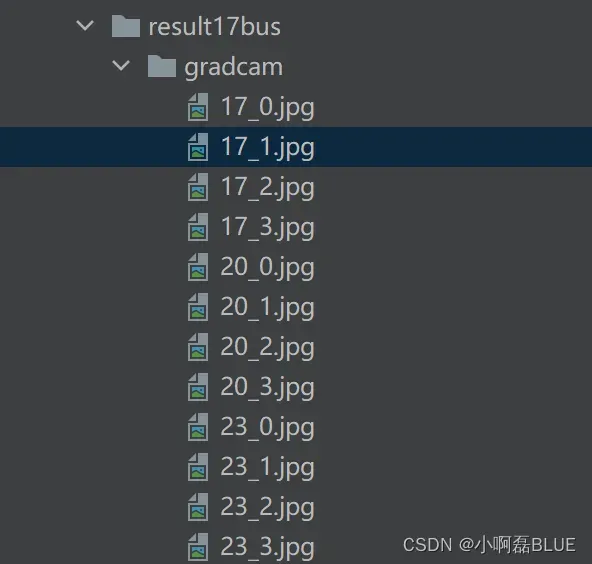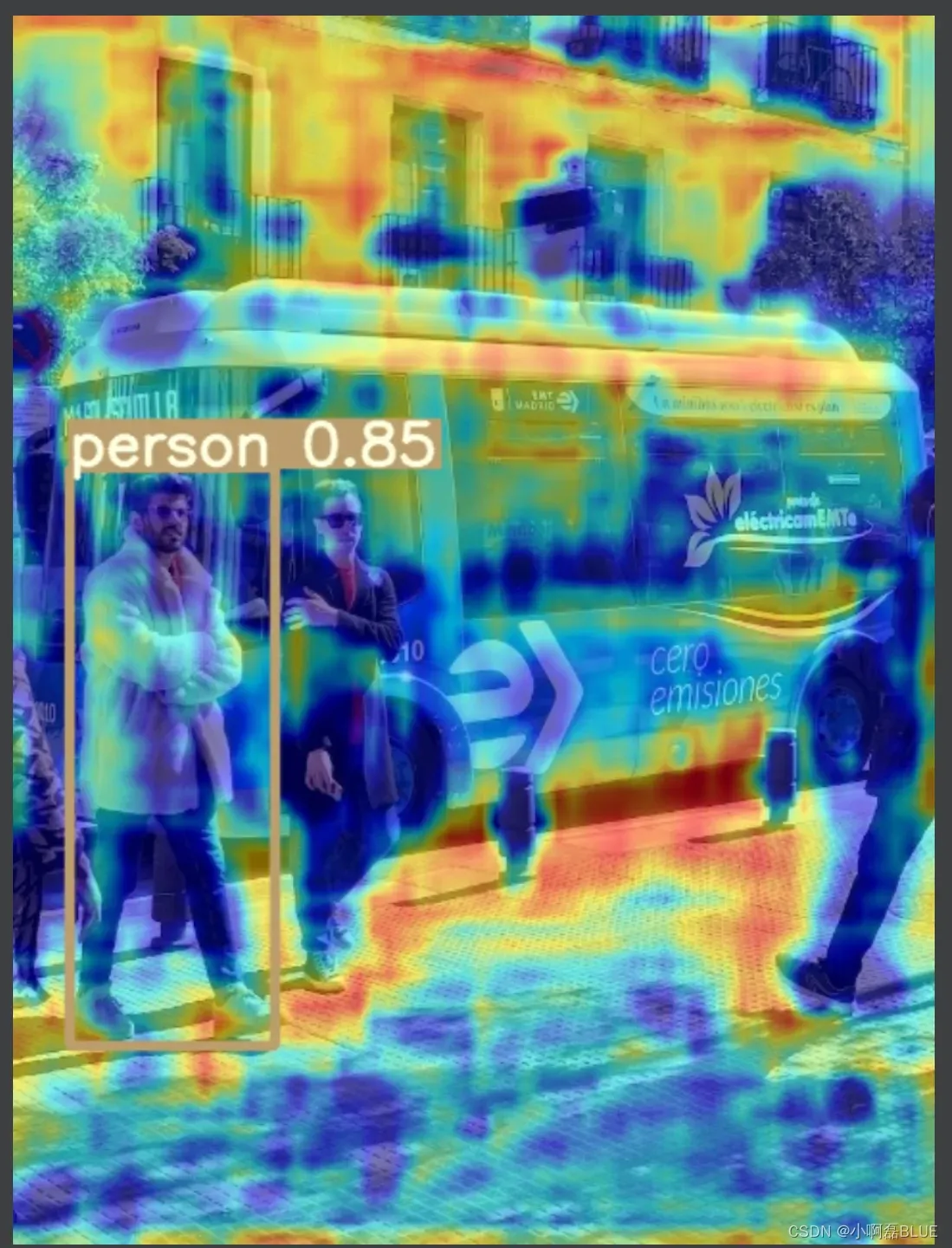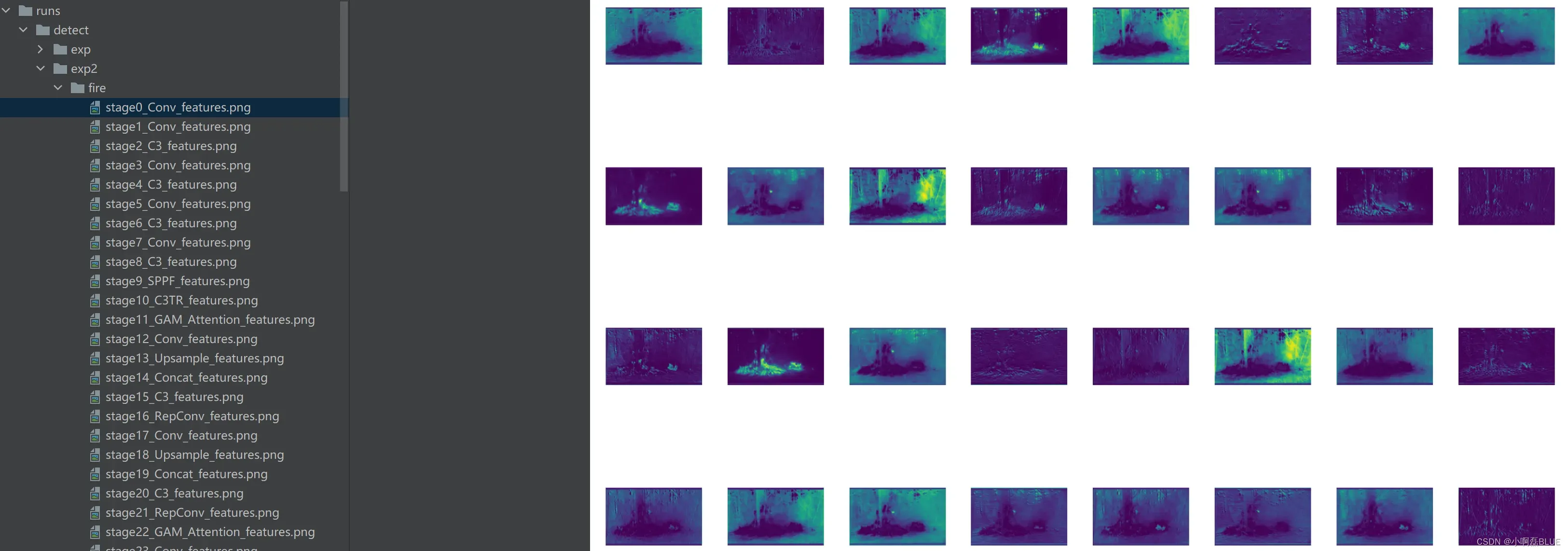YOLO v5结合热力图并可视化
- 目前学习方向: https://github.com/xiaoaleiBLUE
文章目录
- YOLO v5结合热力图并可视化
- @[TOC](文章目录)
- 总结及问题所在
- 一、YOLO v5结合热力图并可视化
- 1.1 在项目文件下添加main_gradcam.py文件
- 1.1 models文件下添加gradcam.py文件
- 1.2 models文件下添加yolov5_object_detector.py文件
- 1.3 修改yolo.py文件
- 1.4 运行main_gradcam.py
- 二、结合自己修改的v5网络实现热力图思路
- 2.1 相关参数解释
- 2.2 参数设置
- 2.3 参数配置
- 2.4 运行结果
- 三、YOLO v5各层特征可视化
- 3.1 utils中的plots.py函数
- 3.2 运行detect.py函数
- 3.2 结果可视化
- @[TOC](文章目录)
- 1.1 在项目文件下添加main_gradcam.py文件
- 1.1 models文件下添加gradcam.py文件
- 1.2 models文件下添加yolov5_object_detector.py文件
- 1.3 修改yolo.py文件
- 1.4 运行main_gradcam.py
- 2.1 相关参数解释
- 2.2 参数设置
- 2.3 参数配置
- 2.4 运行结果
- 3.1 utils中的plots.py函数
- 3.2 运行detect.py函数
- 3.2 结果可视化
总结及问题所在
- YOLO v5结合热力图并可视化,并在官方yolov5s.yaml进行操作,同时在yolov5s.yaml换成自己的数据类别,训练后也可以跑通热力图。但是问题2还没解决。
- 提供一些在自己修改的YOLO v5的网络上结合热力图可视化的一些思路,虽然自己修改后的网络热力图可视化代码跑通,但是相应文件夹的热力图的图片没有出来,目前还在探索,如果跑出来的小伙伴可以交流一下,分享一下问题所在。
- 提供了各层网络可视化特征图的思路。
一、YOLO v5结合热力图并可视化
1.1 在项目文件下添加main_gradcam.py文件
import os
import random
import time
import argparse
import numpy as np
from models.gradcam import YOLOV5GradCAM, YOLOV5GradCAMPP
from models.yolov5_object_detector import YOLOV5TorchObjectDetector
import cv2
# 数据集类别名
names = ['person', 'bicycle', 'car', 'motorcycle', 'airplane', 'bus', 'train', 'truck', 'boat', 'traffic light',
'fire hydrant', 'stop sign', 'parking meter', 'bench', 'bird', 'cat', 'dog', 'horse', 'sheep', 'cow',
'elephant', 'bear', 'zebra', 'giraffe', 'backpack', 'umbrella', 'handbag', 'tie', 'suitcase', 'frisbee',
'skis', 'snowboard', 'sports ball', 'kite', 'baseball bat', 'baseball glove', 'skateboard', 'surfboard',
'tennis racket', 'bottle', 'wine glass', 'cup', 'fork', 'knife', 'spoon', 'bowl', 'banana', 'apple',
'sandwich', 'orange', 'broccoli', 'carrot', 'hot dog', 'pizza', 'donut', 'cake', 'chair', 'couch',
'potted plant', 'bed', 'dining table', 'toilet', 'tv', 'laptop', 'mouse', 'remote', 'keyboard', 'cell phone',
'microwave', 'oven', 'toaster', 'sink', 'refrigerator', 'book', 'clock', 'vase', 'scissors', 'teddy bear',
'hair drier', 'toothbrush'] # class names
# yolov5s网络中的三个detect层
target_layers = ['model_17_cv3_act', 'model_20_cv3_act', 'model_23_cv3_act']
# Arguments
parser = argparse.ArgumentParser()
# yolov5 权重文件
parser.add_argument('--model-path', type=str, default="yolov5s.pt", help='Path to the model')
# 需要可视化的图片
parser.add_argument('--img-path', type=str, default='data/images/bus.jpg', help='input image path')
# 可视化输入文件路径
parser.add_argument('--output-dir', type=str, default='runs/result17', help='output dir')
parser.add_argument('--img-size', type=int, default=640, help="input image size")
# target-layer
parser.add_argument('--target-layer', type=str, default='model_17_cv3_act',
help='The layer hierarchical address to which gradcam will applied,'
' the names should be separated by underline')
parser.add_argument('--method', type=str, default='gradcam', help='gradcam method')
parser.add_argument('--device', type=str, default='cuda', help='cuda or cpu')
parser.add_argument('--no_text_box', action='store_true',
help='do not show label and box on the heatmap')
args = parser.parse_args()
def get_res_img(bbox, mask, res_img):
mask = mask.squeeze(0).mul(255).add_(0.5).clamp_(0, 255).permute(1, 2, 0).detach().cpu().numpy().astype(
np.uint8)
heatmap = cv2.applyColorMap(mask, cv2.COLORMAP_JET)
# n_heatmat = (Box.fill_outer_box(heatmap, bbox) / 255).astype(np.float32)
n_heatmat = (heatmap / 255).astype(np.float32)
res_img = res_img / 255
res_img = cv2.add(res_img, n_heatmat)
res_img = (res_img / res_img.max())
return res_img, n_heatmat
def plot_one_box(x, img, color=None, label=None, line_thickness=3):
# this is a bug in cv2. It does not put box on a converted image from torch unless it's buffered and read again!
cv2.imwrite('temp.jpg', (img * 255).astype(np.uint8))
img = cv2.imread('temp.jpg')
# Plots one bounding box on image img
tl = line_thickness or round(0.002 * (img.shape[0] + img.shape[1]) / 2) + 1 # line/font thickness
color = color or [random.randint(0, 255) for _ in range(3)]
c1, c2 = (int(x[0]), int(x[1])), (int(x[2]), int(x[3]))
cv2.rectangle(img, c1, c2, color, thickness=tl, lineType=cv2.LINE_AA)
if label:
tf = max(tl - 1, 1) # font thickness
t_size = cv2.getTextSize(label, 0, fontScale=tl / 3, thickness=tf)[0]
outside = c1[1] - t_size[1] - 3 >= 0 # label fits outside box up
c2 = c1[0] + t_size[0], c1[1] - t_size[1] - 3 if outside else c1[1] + t_size[1] + 3
outsize_right = c2[0] - img.shape[:2][1] > 0 # label fits outside box right
c1 = c1[0] - (c2[0] - img.shape[:2][1]) if outsize_right else c1[0], c1[1]
c2 = c2[0] - (c2[0] - img.shape[:2][1]) if outsize_right else c2[0], c2[1]
cv2.rectangle(img, c1, c2, color, -1, cv2.LINE_AA) # filled
cv2.putText(img, label, (c1[0], c1[1] - 2 if outside else c2[1] - 2), 0, tl / 3, [225, 255, 255], thickness=tf,
lineType=cv2.LINE_AA)
return img
# 检测单个图片
def main(img_path):
colors = [[random.randint(0, 255) for _ in range(3)] for _ in names]
device = args.device
input_size = (args.img_size, args.img_size)
# 读入图片
img = cv2.imread(img_path) # 读取图像格式:BGR
print('[INFO] Loading the model')
# 实例化YOLOv5模型,得到检测结果
model = YOLOV5TorchObjectDetector(args.model_path, device, img_size=input_size, names=names)
# img[..., ::-1]: BGR --> RGB
# (480, 640, 3) --> (1, 3, 480, 640)
torch_img = model.preprocessing(img[..., ::-1])
tic = time.time()
# 遍历三层检测层
for target_layer in target_layers:
# 获取grad-cam方法
if args.method == 'gradcam':
saliency_method = YOLOV5GradCAM(model=model, layer_name=target_layer, img_size=input_size)
elif args.method == 'gradcampp':
saliency_method = YOLOV5GradCAMPP(model=model, layer_name=target_layer, img_size=input_size)
masks, logits, [boxes, _, class_names, conf] = saliency_method(torch_img) # 得到预测结果
result = torch_img.squeeze(0).mul(255).add_(0.5).clamp_(0, 255).permute(1, 2, 0).detach().cpu().numpy()
result = result[..., ::-1] # convert to bgr
# 保存设置
imgae_name = os.path.basename(img_path) # 获取图片名
save_path = f'{args.output_dir}{imgae_name[:-4]}/{args.method}'
if not os.path.exists(save_path):
os.makedirs(save_path)
print(f'[INFO] Saving the final image at {save_path}')
# 遍历每张图片中的每个目标
for i, mask in enumerate(masks):
# 遍历图片中的每个目标
res_img = result.copy()
# 获取目标的位置和类别信息
bbox, cls_name = boxes[0][i], class_names[0][i]
label = f'{cls_name} {conf[0][i]}' # 类别+置信分数
# 获取目标的热力图
res_img, heat_map = get_res_img(bbox, mask, res_img)
res_img = plot_one_box(bbox, res_img, label=label, color=colors[int(names.index(cls_name))],
line_thickness=3)
# 缩放到原图片大小
res_img = cv2.resize(res_img, dsize=(img.shape[:-1][::-1]))
output_path = f'{save_path}/{target_layer[6:8]}_{i}.jpg'
cv2.imwrite(output_path, res_img)
print(f'{target_layer[6:8]}_{i}.jpg done!!')
print(f'Total time : {round(time.time() - tic, 4)} s')
if __name__ == '__main__':
# 图片路径为文件夹
if os.path.isdir(args.img_path):
img_list = os.listdir(args.img_path)
print(img_list)
for item in img_list:
# 依次获取文件夹中的图片名,组合成图片的路径
main(os.path.join(args.img_path, item))
# 单个图片
else:
main(args.img_path)
1.1 models文件下添加gradcam.py文件
- 我们发现在import出错
- from models.gradcam import YOLOV5GradCAM, YOLOV5GradCAMPP 出错
- from models.yolov5_object_detector import YOLOV5TorchObjectDetector 出错
- gradcam.py文件代码如下
import time
import torch
import torch.nn.functional as F
def find_yolo_layer(model, layer_name):
"""Find yolov5 layer to calculate GradCAM and GradCAM++
Args:
model: yolov5 model.
layer_name (str): the name of layer with its hierarchical information.
Return:
target_layer: found layer
"""
hierarchy = layer_name.split('_')
target_layer = model.model._modules[hierarchy[0]]
for h in hierarchy[1:]:
target_layer = target_layer._modules[h]
return target_layer
class YOLOV5GradCAM:
# 初始化,得到target_layer层
def __init__(self, model, layer_name, img_size=(640, 640)):
self.model = model
self.gradients = dict()
self.activations = dict()
def backward_hook(module, grad_input, grad_output):
self.gradients['value'] = grad_output[0]
return None
def forward_hook(module, input, output):
self.activations['value'] = output
return None
target_layer = find_yolo_layer(self.model, layer_name)
# 获取forward过程中每层的输入和输出,用于对比hook是不是正确记录
target_layer.register_forward_hook(forward_hook)
target_layer.register_full_backward_hook(backward_hook)
device = 'cuda' if next(self.model.model.parameters()).is_cuda else 'cpu'
self.model(torch.zeros(1, 3, *img_size, device=device))
def forward(self, input_img, class_idx=True):
"""
Args:
input_img: input image with shape of (1, 3, H, W)
Return:
mask: saliency map of the same spatial dimension with input
logit: model output
preds: The object predictions
"""
saliency_maps = []
b, c, h, w = input_img.size()
preds, logits = self.model(input_img)
for logit, cls, cls_name in zip(logits[0], preds[1][0], preds[2][0]):
if class_idx:
score = logit[cls]
else:
score = logit.max()
self.model.zero_grad()
tic = time.time()
# 获取梯度
score.backward(retain_graph=True)
print(f"[INFO] {cls_name}, model-backward took: ", round(time.time() - tic, 4), 'seconds')
gradients = self.gradients['value']
activations = self.activations['value']
b, k, u, v = gradients.size()
alpha = gradients.view(b, k, -1).mean(2)
weights = alpha.view(b, k, 1, 1)
saliency_map = (weights * activations).sum(1, keepdim=True)
saliency_map = F.relu(saliency_map)
saliency_map = F.interpolate(saliency_map, size=(h, w), mode='bilinear', align_corners=False)
saliency_map_min, saliency_map_max = saliency_map.min(), saliency_map.max()
saliency_map = (saliency_map - saliency_map_min).div(saliency_map_max - saliency_map_min).data
saliency_maps.append(saliency_map)
return saliency_maps, logits, preds
def __call__(self, input_img):
return self.forward(input_img)
class YOLOV5GradCAMPP(YOLOV5GradCAM):
def __init__(self, model, layer_name, img_size=(640, 640)):
super(YOLOV5GradCAMPP, self).__init__(model, layer_name, img_size)
def forward(self, input_img, class_idx=True):
saliency_maps = []
b, c, h, w = input_img.size()
tic = time.time()
preds, logits = self.model(input_img)
print("[INFO] model-forward took: ", round(time.time() - tic, 4), 'seconds')
for logit, cls, cls_name in zip(logits[0], preds[1][0], preds[2][0]):
if class_idx:
score = logit[cls]
else:
score = logit.max()
self.model.zero_grad()
tic = time.time()
# 获取梯度
score.backward(retain_graph=True)
print(f"[INFO] {cls_name}, model-backward took: ", round(time.time() - tic, 4), 'seconds')
gradients = self.gradients['value'] # dS/dA
activations = self.activations['value'] # A
b, k, u, v = gradients.size()
alpha_num = gradients.pow(2)
alpha_denom = gradients.pow(2).mul(2) + \
activations.mul(gradients.pow(3)).view(b, k, u * v).sum(-1, keepdim=True).view(b, k, 1, 1)
# torch.where(condition, x, y) condition是条件,满足条件就返回x,不满足就返回y
alpha_denom = torch.where(alpha_denom != 0.0, alpha_denom, torch.ones_like(alpha_denom))
alpha = alpha_num.div(alpha_denom + 1e-7)
positive_gradients = F.relu(score.exp() * gradients) # ReLU(dY/dA) == ReLU(exp(S)*dS/dA))
weights = (alpha * positive_gradients).view(b, k, u * v).sum(-1).view(b, k, 1, 1)
saliency_map = (weights * activations).sum(1, keepdim=True)
saliency_map = F.relu(saliency_map)
saliency_map = F.interpolate(saliency_map, size=(h, w), mode='bilinear', align_corners=False)
saliency_map_min, saliency_map_max = saliency_map.min(), saliency_map.max()
saliency_map = (saliency_map - saliency_map_min).div(saliency_map_max - saliency_map_min).data
saliency_maps.append(saliency_map)
return saliency_maps, logits, preds
1.2 models文件下添加yolov5_object_detector.py文件
- yolov5_object_detector.py文件代码如下
import numpy as np
import torch
from models.experimental import attempt_load
from utils.general import xywh2xyxy
from utils.dataloaders import letterbox
import cv2
import time
import torchvision
import torch.nn as nn
from utils.metrics import box_iou
class YOLOV5TorchObjectDetector(nn.Module):
def __init__(self,
model_weight,
device,
img_size,
names=None,
mode='eval',
confidence=0.45,
iou_thresh=0.45,
agnostic_nms=False):
super(YOLOV5TorchObjectDetector, self).__init__()
self.device = device
self.model = None
self.img_size = img_size
self.mode = mode
self.confidence = confidence
self.iou_thresh = iou_thresh
self.agnostic = agnostic_nms
self.model = attempt_load(model_weight, inplace=False, fuse=False)
self.model.requires_grad_(True)
self.model.to(device)
if self.mode == 'train':
self.model.train()
else:
self.model.eval()
# fetch the names
if names is None:
self.names = ['your dataset classname']
else:
self.names = names
# preventing cold start
img = torch.zeros((1, 3, *self.img_size), device=device)
self.model(img)
@staticmethod
def non_max_suppression(prediction, logits, conf_thres=0.3, iou_thres=0.45, classes=None, agnostic=False,
multi_label=False, labels=(), max_det=300):
"""Runs Non-Maximum Suppression (NMS) on inference and logits results
Returns:
list of detections, on (n,6) tensor per image [xyxy, conf, cls] and pruned input logits (n, number-classes)
"""
nc = prediction.shape[2] - 5 # number of classes
xc = prediction[..., 4] > conf_thres # candidates
# Checks
assert 0 <= conf_thres <= 1, f'Invalid Confidence threshold {conf_thres}, valid values are between 0.0 and 1.0'
assert 0 <= iou_thres <= 1, f'Invalid IoU {iou_thres}, valid values are between 0.0 and 1.0'
# Settings
min_wh, max_wh = 2, 4096 # (pixels) minimum and maximum box width and height
max_nms = 30000 # maximum number of boxes into torchvision.ops.nms()
time_limit = 10.0 # seconds to quit after
redundant = True # require redundant detections
multi_label &= nc > 1 # multiple labels per box (adds 0.5ms/img)
merge = False # use merge-NMS
t = time.time()
output = [torch.zeros((0, 6), device=prediction.device)] * prediction.shape[0]
logits_output = [torch.zeros((0, nc), device=logits.device)] * logits.shape[0]
# logits_output = [torch.zeros((0, 80), device=logits.device)] * logits.shape[0]
for xi, (x, log_) in enumerate(zip(prediction, logits)): # image index, image inference
# Apply constraints
# x[((x[..., 2:4] < min_wh) | (x[..., 2:4] > max_wh)).any(1), 4] = 0 # width-height
x = x[xc[xi]] # confidence
log_ = log_[xc[xi]]
# Cat apriori labels if autolabelling
if labels and len(labels[xi]):
l = labels[xi]
v = torch.zeros((len(l), nc + 5), device=x.device)
v[:, :4] = l[:, 1:5] # box
v[:, 4] = 1.0 # conf
v[range(len(l)), l[:, 0].long() + 5] = 1.0 # cls
x = torch.cat((x, v), 0)
# If none remain process next image
if not x.shape[0]:
continue
# Compute conf
x[:, 5:] *= x[:, 4:5] # conf = obj_conf * cls_conf
# Box (center x, center y, width, height) to (x1, y1, x2, y2)
box = xywh2xyxy(x[:, :4])
# Detections matrix nx6 (xyxy, conf, cls)
if multi_label:
i, j = (x[:, 5:] > conf_thres).nonzero(as_tuple=False).T
x = torch.cat((box[i], x[i, j + 5, None], j[:, None].float()), 1)
else: # best class only
conf, j = x[:, 5:].max(1, keepdim=True)
x = torch.cat((box, conf, j.float()), 1)[conf.view(-1) > conf_thres]
log_ = log_[conf.view(-1) > conf_thres]
# Filter by class
if classes is not None:
x = x[(x[:, 5:6] == torch.tensor(classes, device=x.device)).any(1)]
# Check shape
n = x.shape[0] # number of boxes
if not n: # no boxes
continue
elif n > max_nms: # excess boxes
x = x[x[:, 4].argsort(descending=True)[:max_nms]] # sort by confidence
# Batched NMS
c = x[:, 5:6] * (0 if agnostic else max_wh) # classes
boxes, scores = x[:, :4] + c, x[:, 4] # boxes (offset by class), scores
i = torchvision.ops.nms(boxes, scores, iou_thres) # NMS
if i.shape[0] > max_det: # limit detections
i = i[:max_det]
if merge and (1 < n < 3E3): # Merge NMS (boxes merged using weighted mean)
# update boxes as boxes(i,4) = weights(i,n) * boxes(n,4)
iou = box_iou(boxes[i], boxes) > iou_thres # iou matrix
weights = iou * scores[None] # box weights
x[i, :4] = torch.mm(weights, x[:, :4]).float() / weights.sum(1, keepdim=True) # merged boxes
if redundant:
i = i[iou.sum(1) > 1] # require redundancy
output[xi] = x[i]
logits_output[xi] = log_[i]
assert log_[i].shape[0] == x[i].shape[0]
if (time.time() - t) > time_limit:
print(f'WARNING: NMS time limit {time_limit}s exceeded')
break # time limit exceeded
return output, logits_output
@staticmethod
def yolo_resize(img, new_shape=(640, 640), color=(114, 114, 114), auto=True, scaleFill=False, scaleup=True):
return letterbox(img, new_shape=new_shape, color=color, auto=auto, scaleFill=scaleFill, scaleup=scaleup)
def forward(self, img):
prediction, logits, _ = self.model(img, augment=False)
prediction, logits = self.non_max_suppression(prediction, logits, self.confidence, self.iou_thresh,
classes=None,
agnostic=self.agnostic)
self.boxes, self.class_names, self.classes, self.confidences = [[[] for _ in range(img.shape[0])] for _ in
range(4)]
for i, det in enumerate(prediction): # detections per image
if len(det):
for *xyxy, conf, cls in det:
# 返回整数
bbox = [int(b) for b in xyxy]
self.boxes[i].append(bbox)
self.confidences[i].append(round(conf.item(), 2))
cls = int(cls.item())
self.classes[i].append(cls)
if self.names is not None:
self.class_names[i].append(self.names[cls])
else:
self.class_names[i].append(cls)
return [self.boxes, self.classes, self.class_names, self.confidences], logits
def preprocessing(self, img):
if len(img.shape) != 4:
img = np.expand_dims(img, axis=0)
im0 = img.astype(np.uint8)
img = np.array([self.yolo_resize(im, new_shape=self.img_size)[0] for im in im0])
img = img.transpose((0, 3, 1, 2))
img = np.ascontiguousarray(img)
img = torch.from_numpy(img).to(self.device)
img = img / 255.0
return img
1.3 修改yolo.py文件
- 修改yolo.py中的 class Detect类中的def forward 方法, 修改后
class Detect(nn.Module):
stride = None # strides computed during build
onnx_dynamic = False # ONNX export parameter
export = False # export mode
def __init__(self, nc=80, anchors=(), ch=(), inplace=True): # detection layer
super().__init__()
self.nc = nc # number of classes
self.no = nc + 5 # number of outputs per anchor
self.nl = len(anchors) # number of detection layers
self.na = len(anchors[0]) // 2 # number of anchors
self.grid = [torch.zeros(1)] * self.nl # init grid
self.anchor_grid = [torch.zeros(1)] * self.nl # init anchor grid
self.register_buffer('anchors', torch.tensor(anchors).float().view(self.nl, -1, 2)) # shape(nl,na,2)
self.m = nn.ModuleList(nn.Conv2d(x, self.no * self.na, 1) for x in ch) # output conv
self.inplace = inplace # use inplace ops (e.g. slice assignment)
def forward(self, x):
z = [] # inference output
logits_ = [] # 修改---->1
for i in range(self.nl):
x[i] = self.m[i](x[i]) # conv
bs, _, ny, nx = x[i].shape # x(bs,255,20,20) to x(bs,3,20,20,85)
x[i] = x[i].view(bs, self.na, self.no, ny, nx).permute(0, 1, 3, 4, 2).contiguous()
if not self.training: # inference
if self.onnx_dynamic or self.grid[i].shape[2:4] != x[i].shape[2:4]:
self.grid[i], self.anchor_grid[i] = self._make_grid(nx, ny, i)
logits = x[i][..., 5:] #修改---->2
y = x[i].sigmoid()
if self.inplace:
y[..., 0:2] = (y[..., 0:2] * 2 + self.grid[i]) * self.stride[i] # xy
y[..., 2:4] = (y[..., 2:4] * 2) ** 2 * self.anchor_grid[i] # wh
else: # for YOLOv5 on AWS Inferentia https://github.com/ultralytics/yolov5/pull/2953
xy, wh, conf = y.split((2, 2, self.nc + 1), 4) # y.tensor_split((2, 4, 5), 4) # torch 1.8.0
xy = (xy * 2 + self.grid[i]) * self.stride[i] # xy
wh = (wh * 2) ** 2 * self.anchor_grid[i] # wh
y = torch.cat((xy, wh, conf), 4)
z.append(y.view(bs, -1, self.no))
logits_.append(logits.view(bs, -1, self.no - 5)) # 修改---->3
# return x if self.training else (torch.cat(z, 1),) if self.export else (torch.cat(z, 1), x)
# 修改---->4
return x if self.training else (torch.cat(z, 1), torch.cat(logits_, 1), x)
1.4 运行main_gradcam.py


二、结合自己修改的v5网络实现热力图思路
2.1 相关参数解释
- target_layers是你可视化的层,
- ‘model_17_cv3_act’ : model –> 17层 –> cv3层 –> act层,最终的可视化层是model中的17层中的cv3的act进行可视化,之间层的索引以_来分隔索引区分。
# yolov5s网络中的三个detect层
target_layers = ['model_17_cv3_act', 'model_20_cv3_act', 'model_23_cv3_act']
2.2 参数设置
- 需要修改数据集类别名中names
- 需要修检测的target_layers
- 打印你的模型结构
在main_gradcam.py中的def main函数中打印你的网络模型结构
model = YOLOV5TorchObjectDetector(args.model_path, device, img_size=input_size, names=names)
print(model)
- 由于我修改后的网络层,如spatial_attention中间有’_’号,在索引该层会以target_layers中的索引冲突
- 在gradcam.py文件中进行修改,用‘/’ 来区分层之间的索引
def find_yolo_layer(model, layer_name):
"""Find yolov5 layer to calculate GradCAM and GradCAM++
Args:
model: yolov5 model.
layer_name (str): the name of layer with its hierarchical information.
Return:
target_layer: found layer
"""
hierarchy = layer_name.split('/')
target_layer = model.model._modules[hierarchy[0]]
2.3 参数配置
- 主要是 names, target_layers, –model-path, –img-path
- –model-path是我修改v5网络后,重新训练最好的权重。
# 数据集类别名 class names
names = ['fire']
target_layers = ['model/20/cv3/act', 'model/25/cv3/act', 'model/30/cv3/act']
# Arguments
parser = argparse.ArgumentParser()
# parser.add_argument('--model-path', type=str, default='./pretrained/yolov5s.pt', help='Path to the model')
parser.add_argument('--model-path', type=str, default='runs/train/exp32/weights/best.pt', help='Path to the model')
parser.add_argument('--img-path', type=str, default='data/images/test/fire.jpg', help='input image path')
parser.add_argument('--output-dir', type=str, default='runs/', help='output dir')
parser.add_argument('--img-size', type=int, default=640, help="input image size")
parser.add_argument('--target-layer', type=str, default='model_17_cv3_act',
help='The layer hierarchical address to which gradcam will applied,'
' the names should be separated by underline')
parser.add_argument('--method', type=str, default='gradcam', help='gradcam method')
parser.add_argument('--device', type=str, default='cuda', help='cuda or cpu')
parser.add_argument('--no_text_box', action='store_true',
help='do not show label and box on the heatmap')
args = parser.parse_args()
2.4 运行结果
- 代码运行成功,但还是空的文件夹,目前还在解决中。
三、YOLO v5各层特征可视化
3.1 utils中的plots.py函数
- 进行简单修改,两条语句进行屏蔽
- def feature_visualization中的save_dir=Path(‘runs/detect/exp’)为保存路径
def feature_visualization(x, module_type, stage, n=32, save_dir=Path('runs/detect/exp')):
"""
x: Features to be visualized
module_type: Module type
stage: Module stage within model
n: Maximum number of feature maps to plot
save_dir: Directory to save results
"""
if 'Detect' not in module_type:
batch, channels, height, width = x.shape # batch, channels, height, width
if height > 1 and width > 1:
f = save_dir / f"stage{stage}_{module_type.split('.')[-1]}_features.png" # filename
blocks = torch.chunk(x[0].cpu(), channels, dim=0) # select batch index 0, block by channels
n = min(n, channels) # number of plots
fig, ax = plt.subplots(math.ceil(n / 8), 8, tight_layout=True) # 8 rows x n/8 cols
ax = ax.ravel()
plt.subplots_adjust(wspace=0.05, hspace=0.05)
for i in range(n):
ax[i].imshow(blocks[i].squeeze()) # cmap='gray'
ax[i].axis('off')
LOGGER.info(f'Saving {f}... ({n}/{channels})')
# 屏蔽 ----> 1
# plt.title('Features')
plt.savefig(f, dpi=300, bbox_inches='tight')
plt.close()
# 屏蔽 ----> 2
# np.save(str(f.with_suffix('.npy')), x[0].cpu().numpy()) # npy save
3.2 运行detect.py函数
python detect.py --weights runs/train/exp32/weights/best.pt --source data/images/test/fire.jpg --visualize
3.2 结果可视化
- save_dir=Path(‘runs/detect/exp’)为保存路径
文章出处登录后可见!
已经登录?立即刷新



